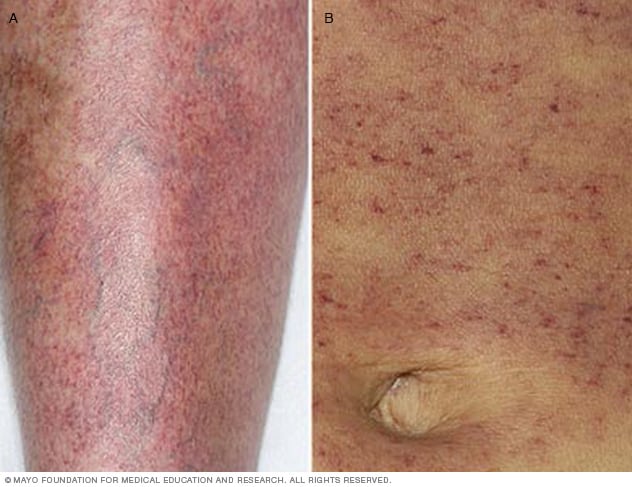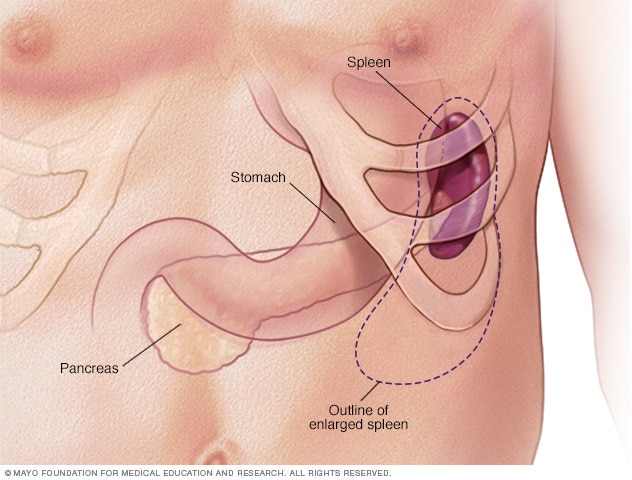Overview
Thrombocytopenia is low blood platelet count. Platelets, also called thrombocytes, are colorless blood cells that help blood clot. Platelets stop bleeding by clumping together and forming plugs in blood vessel injuries.
Thrombocytopenia (throm-boe-sie-toe-PEE-nee-uh) can happen because of conditions or medicines that affect the circulation, production or destruction of blood platelets. Thrombocytopenia can affect both children and adults.
Thrombocytopenia can be mild and cause no symptoms. If platelets become too low, there is a risk of serious bleeding after an injury or during surgery. Rarely, dangerous internal bleeding can occur.
Treatments address the underlying condition causing the low platelet count. In some cases, treatment includes a transfusion of donor platelets.
Products & Services
Symptoms
Petechiae

Petechiae
Petechiae are tiny dots from bleeding under the skin that may look like a rash. On lighter skin, they may be red or purplish. On darker skin, they may be brownish or difficult to see. Here they appear on a leg (A) and on a belly (B).
Symptoms of thrombocytopenia may include:
- Easy or excessive bruising, called purpura, on the skin or inside the mouth.
- Pinpoint-sized dots on the skin, called petechiae, that may be red, purplish or brownish.
- Bleeding from minor cuts that lasts longer than usual.
- Bleeding from the gums or nose.
- Blood in urine or stools.
- Unusually heavy menstrual flows.
When to see a doctor
Make an appointment with your healthcare professional if you have symptoms of thrombocytopenia.
Bleeding that won't stop is a medical emergency. Seek immediate help for bleeding that can't be controlled by the usual first-aid techniques, such as applying pressure to the area.
Causes
Enlarged spleen

Enlarged spleen
The spleen is a small organ typically about the size of your fist. But a number of conditions, including liver disease and some cancers, can cause your spleen to enlarge.
Platelets are produced in bone marrow. Each platelet lives about 7 to 10 days, so bone marrow is always renewing the supply and releasing it into the blood.
Thrombocytopenia is a platelet count lower than 135,000 platelets per microliter of blood in men and lower than 157,000 platelets per microliter of blood in women. Some clinics or labs may use slightly different numbers.
A large, rapid drop in platelets may result in a count higher than these targets, but this drop may still indicate a condition affecting platelet levels.
The causes of a decline in a platelet count fall into three categories:
- Platelets are trapped and not circulating.
- Not enough platelets are made.
- Platelets are being destroyed or used up.
Trapped platelets
The spleen is a small organ about the size of your fist situated just below your rib cage on the left side of your abdomen. The spleen works to fight infection and filter unwanted material from your blood.
An enlarged spleen — which can be caused by a number of disorders — can hold too many platelets. This decreases the number of platelets circulating in the bloodstream.
Decreased production of platelets
Platelets are produced in your bone marrow. Factors that can decrease platelet production include:
- Cancers and other diseases of the bone marrow.
- Chemotherapy medicines and radiation therapy.
- Heavy alcohol consumption.
- Poor nutrition, particularly low iron, folate and vitamin B12.
- Inherited disorders.
- Certain viral infections.
Platelets destroyed or used up
Some conditions cause your body to use up or destroy platelets faster than they're produced. This leads to a shortage of platelets in your bloodstream. Examples of such conditions include:
- Medicines. The destruction of platelets may be a side effect of some medicines. Usually, this means the medicine causes the immune system to see platelets as things that needs to be destroyed. Examples include quinine, sulfa-containing antibiotics and anticonvulsants.
- Immune system disorders. In autoimmune disorders, the immune system attacks healthy tissue instead of germs. Autoimmune disorders that can destroy platelets include immune thrombocytopenia with purpura, lupus and others.
- Infections. Bacterial or fungal infections in the blood can directly destroy platelets. Severe bacterial or viral infections, including HIV and hepatitis C, can cause the immune system to attack platelets.
- Pregnancy. Thrombocytopenia can develop in pregnancy, most often late in the pregnancy. It usually doesn't cause symptoms and improves after delivery. Thrombocytopenia with preeclampsia increases the risk of complications. Preeclampsia results in high blood pressure and signs of kidney dysfunction.
Low platelets and blood clot risk
Sometimes a platelet count is low because platelets are activated as if they were responding to an injury. The activated platelets clump together to form clots when there is no injury. The count is low because the platelets are used up faster than they are being replaced.
These blood clots create a serious risk of blocked blood circulation that can cause life-threatening tissue or organ damage.
Conditions or factors that can cause a low platelet count with blood clotting include:
- Heparin use. Heparin is a blood-thinning medicine. Sometimes it binds to platelets and activates them.
- Thrombotic microangiopathies. This is a group of disorders that result in multiple clots in tiny blood vessels that can occur in any tissues of the body. These may be related to an autoimmune disorder, infection, medicines or other medical conditions.
- COVID-19. Rarely, a COVID-19 infection or a COVID-19 vaccine can trigger the immune system to activate platelets.
Complications
Generally, the lower the platelet count, the greater the risk for complications of excessive bleeding or clotting.
A platelet count is checked before having procedures that involve bleeding, such as surgery. Rarely, internal bleeding can happen without injury when a platelet count is very low.